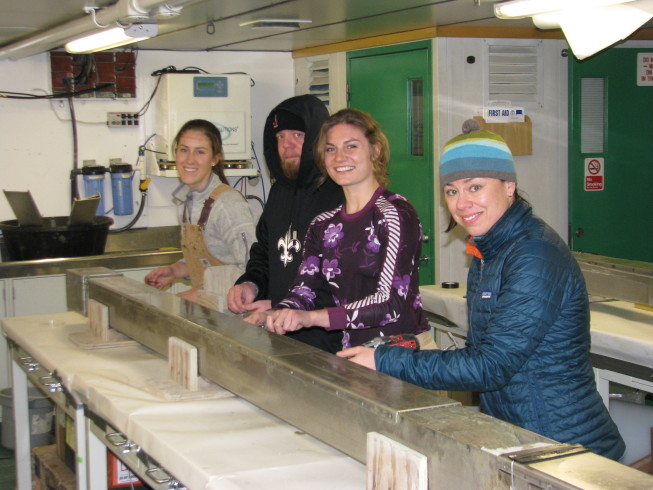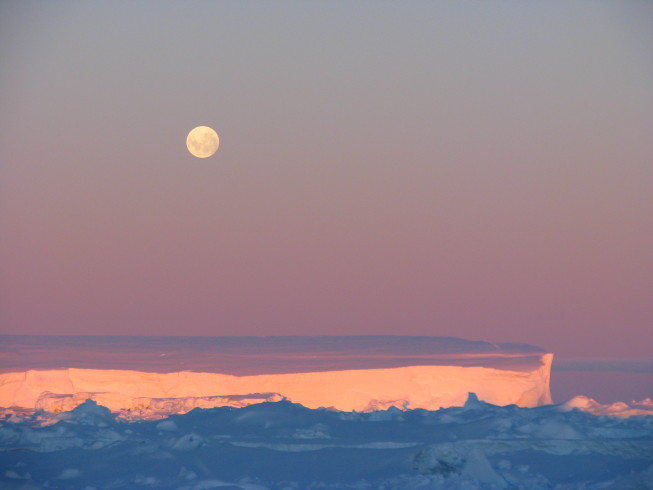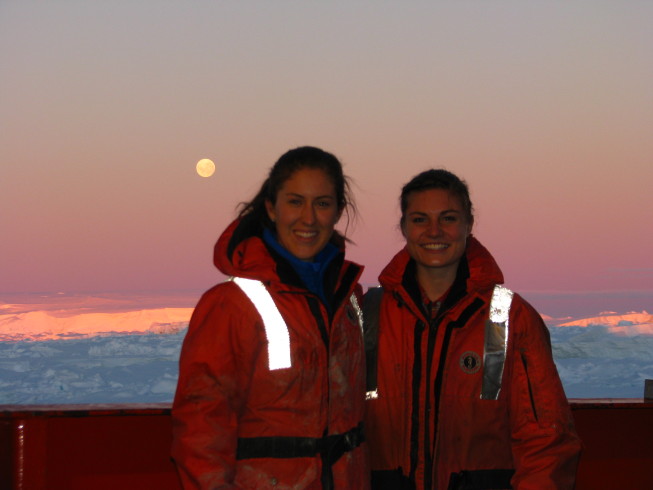February 15, 2014
Apologies for the delay in updates, but we return with exciting news. The past few days have been a whirlwind of scientific exploration. Our captain steered the Palmer toward a small area of open water close to the Totten Glacier. With great weather, clear skies, and good visibility, we were able to chart new waters, working in areas previously uncharted. We are truly exploring new territory. It was an exciting and humbling experience viewing the glacier from the bow and knowing we were the first people to admire this particular view. Luckily for us, the sun was shining during the day and a full moon rose at night, making the view spectacular.
Unfortunately, due to the concentration of thick, hard, old pack ice, we weren’t able to reach the open water right next to the glacier; it stopped us short by less than a few miles, with open water in view. While the ice prevented us from reaching the Totten Glacier front, we were able to recover a Jumbo Piston core, accompanying Trigger core, and a Gravity core from the region between 35 and 75 nautical miles to the northeast of the glacier. The last two days have been spent helping our tireless crew of Marine Technicians recover the cores and sample them.

A truly interdisciplinary approach: students Kara Vadman and Mikhaila Redovian, professor Amelia Shevenell, and cook Mike Bowen tackle a Kasten core together.
In total, we have taken three Kasten cores, one Jumbo Piston core, and one Gravity core. These cores differ from each other in terms of size and function. Kasten cores range from 1.5 meters to 6 meters in length, and have a 12 cm square cross-section. The wide cross-sectional area of the Kasten cores allows us to recover a good sediment-water interface, so that the most recent sedimentary history is captured. Gravity cores and Jumbo Piston cores are round sections of PVC pipe. On the N.B. Palmer, the Jumbo Piston cores can be as long as 24 meters, which is the length of free space along the aft starboard side of the ship. Piston cores and Gravity cores typically are used to recover greater lengths of sediment and/or to recover sediment in places where extra force may be needed to break through clay-rich, gravelly, or sandy layers. These Jumbo Piston and Gravity cores are sent back intact to the Antarctic Marine Geology Research Facility at Florida State University. Our science crew will visit the repository to open and sample the cores after we return and they are delivered. Kasten cores are processed completely on board ship; one Kasten core may take 12 or more hours to sample.
The first step in processing a Kasten core is cleaning the surface to ensure accurate description and sampling. Cleaning involves removing a cross-section of sediment along the core, leaving a clean, smooth surface that still preserves the undisturbed original bedding structures and layers. The structures and the apparent physical characteristics are described and photographed. This photo log keeps a record of the core’s appearance and serves as a reference point for later analysis in the lab. After the photo log is complete, sampling begins. Samples are taken for a variety of purposes, using a variety of methods. 30 cc syringes are used to collect samples for foraminiferal work and for organic geochemical analyses. Rectangular 1 cm sections are then taken from the core and are used to describe the physical properties of the sediment such as water content and grain size. Then diatom and radiocarbon samples are taken. After all of this sampling is complete, the surface of the core is riddled with signs of our experimentation, so the surface must be recleaned. When the core surface is again smooth, more samples are taken for x-ray imaging and finally, for archiving. All of these samples will be taken back to various labs to be analyzed by specialists before the data is shared. The combination of various techniques allows for interpretation of past climate, as well as specific dates to correlate the findings to geologic history. Our interdisciplinary research plan is designed to help us achieve the goal of this cruise, which is to better understand the history of the Totten Glacier system.





Kara and Mikhaila,
Enjoyed your blog – so glad you are having such an amazing experience!
We miss you at base camp,
Roxanne
Hey Kara and Mikhaila! I am so glad you both are getting to see and do such interesting things! Hope you are having fun! – Sam Sloane
Love reading about your experience. Safe travels through out. :0)